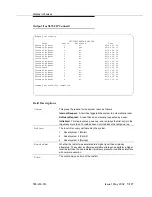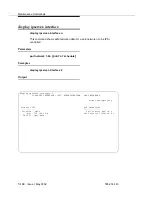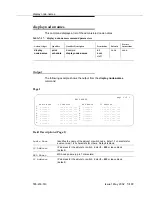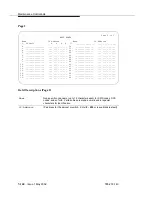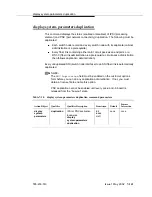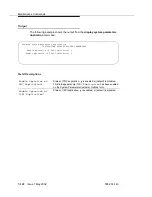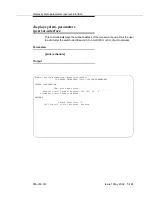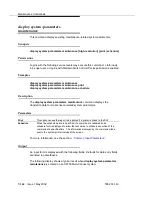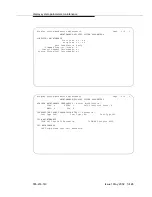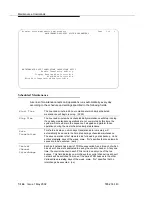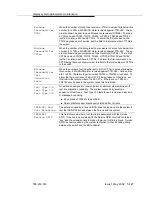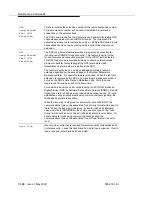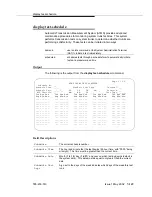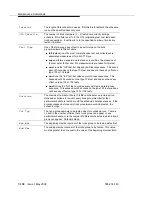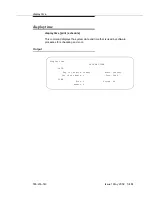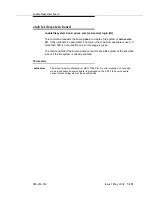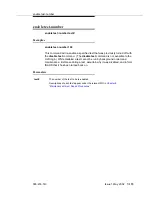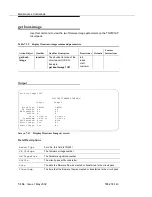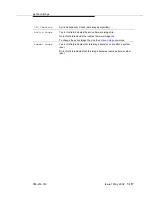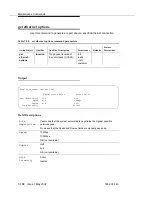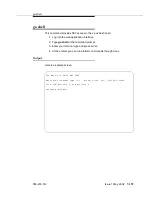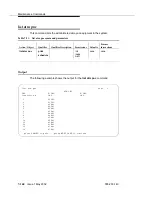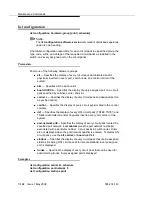
display system-parameters maintenance
Issue 1 May 2002
7-147
555-233-143
Minimum
Threshold for
TTRs
When the number of touch-tone receivers (TTRs) in service falls below this
number (4 to 200), a WARNING alarm is raised against TTR-LEV. These
are also known as dual-tone multifrequency receivers (DTMRs). There are
4 TTRs on each TN748, TN718, TN420, or TN756; TN2182 and TN744
(suffix C or later) each have 8 TTRs. To alarm the first occurrence of a
TTR being taken out of service, set this field to the total number of TTRs in
the switch.
Minimum
Threshold for
CPTRs
When the number of call progress tone receivers in service falls below this
number (2 to 100), a WARNING alarm is raised against TTR-LEV. These
are also known as general purpose Tone Detectors (GPTDs). There are 2
CPTRs on each TN748, TN718, TN420, or TN756; TN2182 and TN744
(suffix C or later) each have 8 CPTRs. To alarm the first occurrence of a
CPTR being taken out of service, set this field to the total number of CPTRs
in the switch.
Minimum
Threshold for
Call
Classifier
Ports
When the number of call classifier ports (CLSFY-PTs) in service falls below
this number, a WARNING alarm is raised against TTR-LEV. Valid entries
are 1 to 200. There are 8 ports on each TN744 or TN2182 circuit pack. To
alarm the first occurrence of a CLSFY-PT being taken out of service, set
this field to the total number of CLSFY-PTs. If there are no TN744 or
TN2182 circuit packs in the system, leave this field blank.
Test Type 100,
Test Type 102,
Test Type 105
An extension assigned to receive tie-trunk calls from other switches with
test line origination capability. The system responds by sending a
sequence of test tones. Test Type 100 tests far-end to near-end loss and
C-message by sending:
■
5.5 seconds of 1004-Hz tone at 0dB
■
Quiet until disconnect; disconnect is forced after 1 minute
ISDN-PRI Test
Call Extension
The extension used by a far-end ISDN node to place a call to the system to
test the ISDN-PRI trunks between the far end and the system.
ISDN-BRI
Service SPID
This field shows whether or not the link is associated with the Service
SPID. If the link is associated with the Service SPID, this field contains a
“yes” and the extension field is blank; otherwise, this field is blank. Service
SPID is a feature used by the system technician to check building wiring
between the switch and the BRI endpoint.
Summary of Contents for S8700 Series
Page 50: ...Maintenance Architecture 555 233 143 1 26 Issue 1 May 2002 ...
Page 74: ...Initialization and Recovery 555 233 143 3 12 Issue 1 May 2002 ...
Page 186: ...Alarms Errors and Troubleshooting 555 233 143 4 112 Issue 1 May 2002 ...
Page 232: ...Additional Maintenance Procedures 555 233 143 5 46 Issue 1 May 2002 ...
Page 635: ...status psa Issue 1 May 2002 7 379 555 233 143 status psa See status tti on page 7 406 ...
Page 722: ...Maintenance Commands 555 233 143 7 466 Issue 1 May 2002 ...





